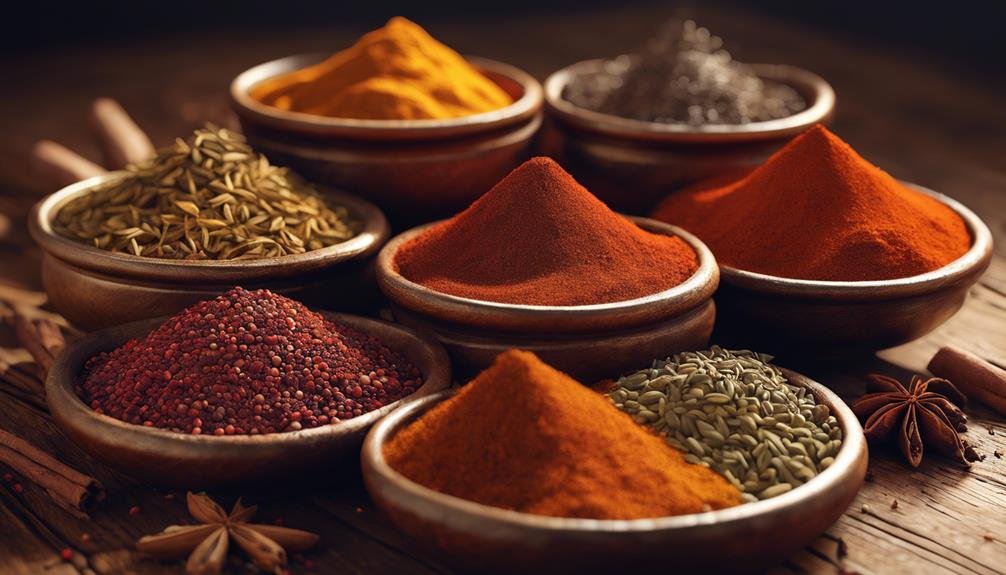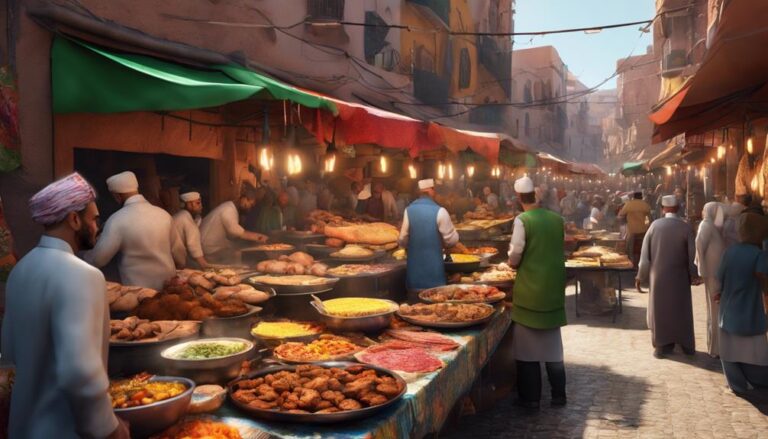Immerse yourself in Morocco's culinary journey with iconic spices like cumin, adding warmth to traditional tagines. Paprika, symbolizing heritage, infuses dishes with vibrant colors. Ginger, a versatile staple, brings depth to sweet and savory creations. Cinnamon, symbolizing hospitality, offers warmth and sweetness to tagines and pastries. Saffron, the prized 'red gold,' elevates dishes with its floral touch. Each spice reflects Morocco's history and geography, making your culinary exploration richer. Discover more about these spices and their cultural influences to deepen your appreciation for the flavors and traditions of Moroccan cuisine.
Key Takeaways
- Cumin is a staple with warm, earthy flavors.
- Paprika adds vibrant color and distinct taste.
- Ginger enhances dishes with warmth and depth.
- Cinnamon adds sweetness to savory and sweet dishes.
- Saffron brings floral aroma and luxury to recipes.
Cumin
Cumin, a staple in Moroccan cuisine, adds a warm and earthy flavor to dishes, enhancing the overall taste experience. In Morocco, cumin is a fundamental spice used in various traditional dishes, imparting a unique and rich taste. One of the most iconic Moroccan cumin dishes is the flavorful tagine, where the spice blends beautifully with other ingredients like lamb, vegetables, and dried fruits, creating a harmonious and aromatic meal.
Apart from its culinary significance, cumin also offers several health benefits. It's known for aiding digestion, reducing inflammation, and even potentially improving blood cholesterol levels. The spice is rich in iron and may help boost the immune system due to its antimicrobial properties. With its distinctive flavor profile and health-boosting properties, cumin hasn't only contributed to the deliciousness of Moroccan cuisine but also to the well-being of those who enjoy its flavorful offerings.
Paprika
In Moroccan cuisine, paprika plays an essential role, infusing dishes with its vibrant color and distinct peppery flavor. Paprika isn't only a spice but also a symbol of Morocco's rich culinary heritage. The history of paprika dates back centuries, with its cultivation and usage deeply rooted in Moroccan culinary traditions.
Sweet paprika, a milder variety, offers a range of benefits. It adds a beautiful red hue to dishes while imparting a subtle sweetness that balances out savory flavors. This type of paprika is commonly used in tagines, stews, and couscous dishes, enhancing the overall taste profile.
In contrast, smoked paprika, with its intense and smoky flavor, brings a unique depth to Moroccan recipes. This variety of paprika is often featured in grilled meats, vegetable dishes, and marinades. The smokiness adds a distinctive touch that elevates the dish to a whole new level.
When exploring Moroccan cuisine, be sure to experiment with both sweet and smoked paprika to experience the full spectrum of flavors that this versatile spice has to offer.
Ginger
With the vibrant flavors of paprika still lingering on your palate, let's now uncover the aromatic and zesty world of ginger in Moroccan cuisine. Ginger, a staple in Moroccan cooking, brings a unique warmth and depth to dishes that's both comforting and invigorating. Its historical significance dates back centuries, where it was highly prized for its medicinal properties and culinary uses.
In Moroccan cuisine, ginger is often used in both savory and sweet dishes. It adds a spicy, slightly sweet flavor that pairs well with meats, vegetables, and desserts. From tagines to pastries, ginger plays a versatile role in enriching the overall taste profile of Moroccan dishes.
Apart from its culinary uses, ginger also offers various health benefits. It's known for its anti-inflammatory properties, aiding digestion, and boosting the immune system. Incorporating ginger into your cooking not only enhances the flavor but also contributes to your well-being.
To experience the full potential of ginger in Moroccan cuisine, try recipes like ginger-spiced lamb tagine or ginger-infused couscous. These dishes showcase the versatility and aromatic qualities of ginger, elevating your culinary journey through Moroccan spices.
Cinnamon
Let's talk about cinnamon, a spice deeply woven into Moroccan culinary traditions. Its warm, sweet flavor with hints of spice and citrus adds depth to both savory tagines and sweet pastries.
In Morocco, cinnamon isn't just a spice but a symbol of hospitality and warmth in every dish it graces.
Cinnamons Flavor Profile
Amidst the vibrant tapestry of Moroccan spices, cinnamon stands out with its warm, sweet aroma and versatile flavor profile. Cinnamon has been a prized spice in Moroccan cuisine for centuries, adding depth and richness to both sweet and savory dishes. Its sweet and woody notes complement tagines, couscous, and pastries, creating a harmonious blend of flavors.
Beyond its culinary uses, cinnamon also offers various health benefits. It's known for its antioxidant properties, ability to lower blood sugar levels, and potential anti-inflammatory effects. In Moroccan culture, cinnamon holds a special place, symbolizing warmth, comfort, and hospitality.
Its distinctive taste and aroma continue to enchant taste buds and offer a unique sensory experience in Moroccan dishes.
Culinary Uses of Cinnamon
In Moroccan cuisine, cinnamon plays a pivotal role, infusing dishes with its warm, sweet aroma and enhancing both sweet and savory flavors. Cinnamon is widely used in Moroccan desserts like 'sellou,' a traditional sweet treat made with almonds, sesame seeds, and spices, offering a delightful blend of nuttiness and warmth.
Additionally, savory dishes like tagines and couscous often feature cinnamon, adding a unique depth of flavor to these hearty meals. Apart from its culinary uses, cinnamon also offers various health benefits, including its antioxidant properties and potential to aid in blood sugar regulation.
For those looking for alternatives, cardamom or nutmeg can provide a similar warm and aromatic profile in dishes, making them versatile options in Moroccan cooking.
Saffron
You know that saffron, known as 'red gold,' is a prized spice in Moroccan cuisine for its unique flavor profile and vibrant color.
It has a rich historical significance, once being used as a form of currency due to its rarity and value.
In Moroccan dishes, saffron adds a distinctive floral taste and aroma, elevating tagines, couscous, and other traditional recipes.
Flavor Profile
With its delicate floral aroma and vibrant golden hue, saffron adds a luxurious touch to Moroccan dishes, elevating the flavor profile to new heights. This prized spice offers a spicy sweet flavor that's versatile in dishes, making it a cornerstone in Moroccan cuisine.
Saffron is rich and aromatic, enhancing both savory tagines and sweet desserts with its unique essence. Historically, saffron has been used in Moroccan cooking for centuries, dating back to when it was introduced by Arab traders. Its distinct flavor and color have made it a symbol of luxury and sophistication in Moroccan gastronomy.
Whether used in savory stews or sweet pastries, saffron continues to play a crucial role in defining the intricate flavors of Moroccan cuisine.
Culinary Uses
When incorporating saffron into Moroccan dishes, a mere pinch of this prized spice can transform ordinary flavors into a luxurious culinary experience. Saffron is an essential component in many spice blends used in Moroccan cuisine, adding a distinctive flavor and vibrant yellow color to dishes. This precious spice has a long history in Moroccan cooking, dating back centuries to when it was traded along ancient spice routes. Saffron is often used in cooking techniques such as slow cooking tagines or infusing into rich broths. Its delicate floral notes and earthy undertones make it a versatile ingredient that elevates both savory and sweet dishes in Moroccan gastronomy.
| Emotion | Description |
|---|---|
| Luxurious | Saffron imparts a rich and decadent flavor to dishes. |
| Exotic | The vibrant color of saffron adds an exotic touch to Moroccan cuisine. |
| Historical | Saffron carries a long history in Moroccan culinary traditions. |
Coriander
Exploring the vibrant spice markets of Morocco reveals the essential role that coriander plays in the country's rich culinary heritage. Coriander, known as 'kuzbara' in Moroccan Arabic, is a staple spice used in a variety of traditional dishes. The history of coriander in Moroccan cuisine dates back centuries, with its usage deeply rooted in the country's diverse cultural influences, including Arab, Berber, and Mediterranean.
Coriander recipes in Morocco often feature the spice in tagines, couscous dishes, and harira soup. Its citrusy and slightly peppery flavor adds a unique dimension to savory dishes, enhancing the overall taste profile. In addition to its culinary uses, coriander is known for its various health benefits. It's rich in antioxidants, vitamins, and minerals, making it a valuable ingredient for overall well-being.
Whether sprinkled on top of a fragrant lamb tagine or incorporated into a revitalizing salad, coriander's aromatic touch is a hallmark of Moroccan cooking. Embrace the flavors of Morocco by experimenting with coriander in your own culinary creations.
Conclusion
As you sprinkle cumin and paprika into your tagine, the aroma of Moroccan spices fills the air, transporting you to bustling souks and ancient kasbahs. These flavors, like a tapestry woven with history and tradition, add depth and richness to every dish.
Just as each spice plays a unique role in Moroccan cuisine, blending together harmoniously, so too does the diversity of flavors create a symphony of taste that's uniquely Moroccan.

The Editorial Team is a passionate group of Morocco enthusiasts dedicated to sharing the beauty, culture, and wonders of this captivating country. With diverse backgrounds and a deep love for travel, we strive to bring you engaging and informative content that inspires your Moroccan adventures. From uncovering hidden gems and sharing local insights to exploring mouthwatering cuisine and showcasing the vibrant lifestyle, our team is committed to providing you with valuable resources and exciting stories that enhance your exploration of Morocco. Join us on this journey as we celebrate the rich heritage and unforgettable experiences that make Morocco truly special.







